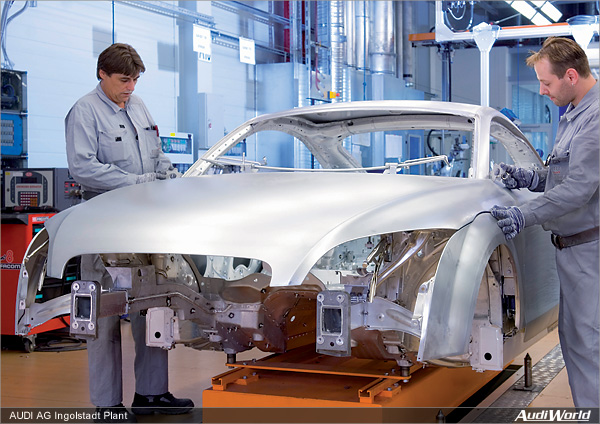Audi AG Ingolstadt Plant – Technical Development

The tasks performed by AUDI AGs Technical Development in Ingolstadt include the development of engines (power units and transmissions), design, electrics/electronics development, body and chassis development, all the way to the development of the total vehicle. The crash tests for vehicle safety are also part of Technical Development, as are the wind tunnel and the EMC measuring hall, where the electronics of the vehicle are tested for electromagnetic compatibility, and the proving ground in Neustadt an der Donau. 4,560 employees work on vehicle development itself in Technical Development, which covers an area of 210,000 square metres: about one third of these are blue-collar workers and two thirds white-collar employees; 61 percent of the latter are engineers. A further 500 employees from the Quality Assurance, Production, Model Line, Purchasing and Controlling divisions are involved in the development process and work in Technical Development. The office premises occupy around 58,000 square metres. 80,000 square metres are devoted to workshops and test rigs. The Electronics Centre was opened in 2003. This transparent, open-plan building concept comprising office, laboratory and workshop areas is where all sections of the company dealing with electronics come together. The seven-storey, terrace-shaped building complex provides working space for 850 employees from the areas of Electronics Development, Purchasing, Quality Assurance, Production Preparation, Service and Controlling. The Electronics Centre houses numerous measuring and testing facilities for vehicles, e.g. a climatic test chamber for weather and road simulations, a light tunnel, an MMI laboratory (Multi Media Interface) and a sound laboratory for the development of hi-fi concepts. There are also various testing facilities for networked electronic components. In 2004 the latest section of the Physikum building was completed. The Physikum has been extended in several construction phases since the foundation stone was laid in 1993 and comprises five modules. The arrangement of office space directly adjacent to workshops, laboratories and test rigs makes for ideal working conditions for the intensive development of total vehicle characteristics. Even before the first prototypes are driven on the road, individual components and later complete vehicles are operated, measured and analysed on the test rigs. The acoustics of the vehicle, for example, are tested on a roller dynamometer. Performance and consumption are measured on a flat-track test rig and a road simulator tests the long-term durability of test vehicles in quick motion within just a few weeks. Since early 1999 the Ingolstadt plant has had its own Wind Tunnel Centre, comprising two test rigs: the aerocoustic wind tunnel and the thermal wind tunnel. The aeroacoustic wind tunnel is the worlds quietest and, at the same time, fastest vehicle wind tunnel. It utilises ultramodern ground simulation technology which exactly reproduces road conditions with rotating wheels and a moving belt. Here, Audis lead in the field of aerodynamics is extended still further to make Audi vehicles even quieter and even more attractive. The thermal wind tunnel is used to develop cooling systems. A further climatic wind tunnel which is currently being built will extend the range of facilities from mid-2007. Since 1995 Technical Development has been able to test new developments in a wide range of driving situations on Audis own proving ground in Neustadt an der Donau. Measurements relating to performance, fuel consumption, noise level, temperature and braking are recorded on a 4.6-kilometre oval track with three lanes and two banked curves. Here, Audi vehicles are put through their paces on various surfaces such as rough asphalt, ruts, bumps, joints between concrete-pavement slabs, expansion joints, lines of nails and longitudinal grooves. The acoustics measuring track is used additionally for measuring exterior noise. Eight test lanes with different gradients ranging between eight and 30 percent lead to the top of a special hill. This is where, for example, hill starts and towing and braking performance with a trailer are tested. Even ice and snow conditions can be simulated with the aid of special surfaces and sprinkling. Tests are also carried out on roads with different surfaces. Front-wheel, rear-wheel and quattro drive are tested on gravel, for example. Test sections with a Belgium pavement surface, undulated concrete, humps and a level crossing are also available. In 2002 an ultramodern Corrosion Protection Centre with salt-water, mud and splash test sections was set up on the proving ground. In 2004 a new test section was set up with various surfaces for simulating good and poor road conditions.
|
